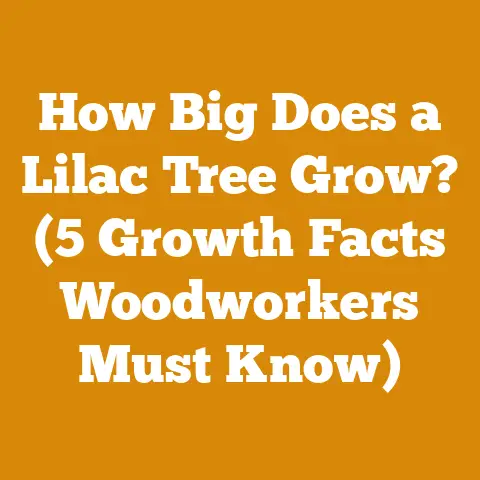How Much Are Japanese Maples Worth (5 Pro Tips for Value)
Let’s dive into the world of Japanese maples and unlock their secrets to understanding their worth.
How Much Are Japanese Maples Worth? (5 Pro Tips for Value)
Japanese maples – those elegant, graceful trees with their vibrant colors and delicate leaves – are prized possessions for many gardeners and homeowners. But determining their actual worth can be a bit of a puzzle. It’s not as simple as just looking at a price tag. Several factors come into play, from the tree’s variety and size to its health and overall aesthetic appeal.
Over the years, I’ve learned a thing or two about valuing trees. I’ve spent countless hours assessing timber quality in the forests, understanding the nuanced differences that separate ordinary trees from exceptional ones. I’ve brought that same discerning eye to the world of ornamental trees, and I’m here to share my insights with you.
In this guide, I’ll walk you through five pro tips that will help you accurately assess the value of a Japanese maple, whether you’re looking to buy, sell, or simply understand the worth of a tree you already own.
1. Variety is the Spice of Life (and the Key to Value)
The first, and perhaps most crucial, factor in determining the value of a Japanese maple is its variety. Just like with any plant, some cultivars are more desirable and, therefore, more valuable than others.
- Popular and Common Varieties: These are your standard Japanese maples, often readily available at nurseries and garden centers. Think ‘Bloodgood,’ ‘Crimson Queen,’ and ‘Emperor I.’ While beautiful, their relative abundance means they typically command lower prices.
- Rare and Unique Varieties: This is where things get interesting (and potentially expensive!). Certain Japanese maple cultivars are rare due to their unique characteristics, difficulty in propagation, or simply limited availability. Examples include ‘Shishigashira’ (Lion’s Mane), ‘Aka Shigitatsu Sawa,’ and some of the variegated varieties. These can fetch significantly higher prices.
- Grafted vs. Seed-Grown: Grafted Japanese maples are generally considered more valuable than those grown from seed. Grafting ensures that the tree retains the exact characteristics of the parent cultivar, while seed-grown trees can exhibit variations.
I remember once coming across a ‘Shishigashira’ at a small, out-of-the-way nursery. It was tucked away in a corner, almost hidden from view. I knew immediately that it was something special. Its tightly curled leaves and upright growth habit were unmistakable. I negotiated a price that was significantly higher than the other maples in the nursery, but I knew it was worth it. Years later, that tree is a stunning centerpiece in my garden.
Pro Tip: Research the specific variety of your Japanese maple. Online resources, books, and local nurseries can help you identify the cultivar and understand its rarity and desirability. Don’t hesitate to ask the seller or nursery staff for information about the tree’s origin and propagation method.
Takeaway: Knowing the variety is the foundation for understanding a Japanese maple’s value.
2. Size Matters (But It’s Not Everything)
As with most trees, size plays a significant role in the value of a Japanese maple. A larger, more mature tree will generally command a higher price than a smaller, younger one. This is due to the time and resources required to grow a tree to a larger size.
- Trunk Diameter: This is a key measurement used to assess the size of a tree. A larger trunk diameter indicates a more mature and established tree.
- Height and Spread: The overall height and spread of the tree also contribute to its value. A well-balanced and aesthetically pleasing form is highly desirable.
- Container Size: If the tree is container-grown, the size of the container can also be an indicator of its age and size.
However, size isn’t the only factor to consider. A large, unhealthy tree is worth less than a smaller, healthy one. A tree that has been poorly pruned or has significant structural defects will also be less valuable, regardless of its size.
I’ve seen plenty of large Japanese maples that were actually worth less than smaller, well-maintained specimens. One particular instance comes to mind: a massive ‘Bloodgood’ that had been severely pruned into an unnatural shape. The owner was convinced it was worth a fortune because of its size, but the poor pruning had significantly diminished its aesthetic appeal and, consequently, its value.
Pro Tip: When assessing the size of a Japanese maple, consider not only its dimensions but also its overall health and form. Look for a well-balanced tree with a strong trunk and healthy branching structure.
Takeaway: Size is important, but health and form are equally crucial.
3. Health is Wealth (Assessing the Tree’s Condition)
The health of a Japanese maple is paramount to its value. A healthy tree will thrive and provide years of enjoyment, while a diseased or damaged tree may require extensive care or even replacement.
- Foliage: Examine the leaves closely for signs of disease, pests, or nutrient deficiencies. Healthy leaves should be vibrant in color and free from spots, holes, or discoloration.
- Branches: Inspect the branches for deadwood, broken limbs, or signs of insect infestation. The bark should be smooth and free from cracks or cankers.
- Trunk: Check the trunk for wounds, decay, or signs of root rot. The trunk should be solid and free from any soft spots.
- Root System: If possible, examine the root system for signs of circling roots or root rot. A healthy root system is essential for the tree’s long-term survival.
I’ve learned the hard way that neglecting tree health can be a costly mistake. Years ago, I purchased a Japanese maple that looked healthy on the surface, but I soon discovered that it had a hidden root rot problem. Despite my best efforts, the tree eventually declined and died. Now, I always make sure to thoroughly inspect the root system before buying any tree.
Pro Tip: Don’t be afraid to get up close and personal with the tree. Use a magnifying glass to examine the leaves and branches for any signs of problems. If you’re unsure about something, consult with a certified arborist.
Takeaway: A healthy tree is a valuable tree. Thoroughly assess the tree’s condition before making a purchase or determining its worth.
4. Aesthetic Appeal (Beauty is in the Eye of the Beholder)
The aesthetic appeal of a Japanese maple is a subjective but important factor in determining its value. A tree with a graceful form, vibrant colors, and interesting branching structure will generally be more valuable than a tree that is poorly shaped or lacks visual interest.
- Form: Look for a tree with a balanced and pleasing form. The branches should be evenly distributed and create a visually appealing silhouette.
- Color: The color of the leaves is a major factor in the aesthetic appeal of a Japanese maple. Different varieties offer a wide range of colors, from deep reds and purples to vibrant greens and yellows.
- Texture: The texture of the leaves and bark can also contribute to the tree’s aesthetic appeal. Some varieties have delicate, finely dissected leaves, while others have more coarse or textured foliage.
- Overall Impression: Step back and take a look at the tree as a whole. Does it catch your eye? Does it evoke a sense of beauty and tranquility?
I’ve always been drawn to Japanese maples with unique and interesting forms. I remember seeing a ‘Contorted Filbert’ (Harry Lauder’s Walking Stick) grafted with a Japanese maple at a local botanical garden. The combination of the twisted branches of the filbert and the delicate foliage of the maple was simply stunning. It was a true work of art.
Pro Tip: When assessing the aesthetic appeal of a Japanese maple, consider its overall form, color, and texture. Choose a tree that appeals to your personal taste and complements your landscape.
Takeaway: Beauty is a valuable asset. A Japanese maple with exceptional aesthetic appeal will command a higher price.
5. Location, Location, Location (and Other Market Factors)
The value of a Japanese maple can also be influenced by factors such as location, market demand, and the reputation of the seller.
- Location: The region where you live can affect the price of Japanese maples. In areas where these trees are popular and in high demand, prices may be higher.
- Market Demand: The overall demand for Japanese maples can fluctuate depending on trends and fashion. When demand is high, prices tend to increase.
- Seller Reputation: Buying from a reputable nursery or tree farm can ensure that you’re getting a healthy, high-quality tree. Reputable sellers often offer guarantees and warranties, which can add value to the purchase.
- Installation Costs: Consider the cost of planting and establishing the tree in your landscape. Larger trees may require professional installation, which can add to the overall expense.
I’ve noticed that the price of Japanese maples tends to be higher in urban areas where space is limited and demand for ornamental trees is high. I also know that certain varieties become trendy from time to time, which can drive up their prices significantly.
Pro Tip: Do your research and compare prices from different sources before making a purchase. Consider the location, market demand, and seller reputation when evaluating the value of a Japanese maple.
Takeaway: External factors can influence the value of a Japanese maple. Be aware of these factors when making a purchase or assessing the worth of a tree you already own.
Understanding Japanese Maple Value: A Deeper Dive
Now that we’ve covered the five pro tips, let’s delve into some additional aspects that can influence the value of Japanese maples.
Grafting Techniques and Rootstock
As I mentioned earlier, grafted Japanese maples are generally considered more valuable than seed-grown trees. But not all grafting techniques are created equal.
- Grafting Methods: Different grafting methods, such as whip grafting, side veneer grafting, and bud grafting, can affect the success rate and the overall quality of the graft union.
- Rootstock Selection: The rootstock used for grafting can also influence the tree’s health, vigor, and disease resistance. Some rootstocks are more compatible with certain Japanese maple varieties than others.
I’ve seen instances where poorly executed grafts resulted in weak or unstable trees that were prone to breakage. Choosing a tree with a strong and well-healed graft union is essential for its long-term health and survival.
Pruning and Training
Proper pruning and training can significantly enhance the aesthetic appeal and value of a Japanese maple.
- Pruning Techniques: Regular pruning can help maintain the tree’s shape, remove deadwood, and improve air circulation.
- Training Methods: Training techniques, such as espalier and bonsai, can create unique and artistic forms that are highly prized by collectors.
I’ve spent years honing my pruning skills, and I’ve learned that a well-pruned Japanese maple can be a true masterpiece. A tree that has been carefully shaped and trained can be worth significantly more than an unpruned specimen.
Soil and Climate Considerations
The soil and climate conditions in your area can also affect the health and value of a Japanese maple.
- Soil Requirements: Japanese maples prefer well-drained, slightly acidic soil. Poor soil conditions can lead to nutrient deficiencies and other health problems.
- Climate Adaptability: Some Japanese maple varieties are more tolerant of heat, cold, and drought than others. Choosing a variety that is well-suited to your local climate is essential for its long-term survival.
I’ve learned that it’s crucial to select a Japanese maple variety that is adapted to your local climate. I once planted a ‘Bloodgood’ in a location that was too exposed to the hot afternoon sun, and the leaves quickly scorched and turned brown.
Case Studies: Real-World Examples of Japanese Maple Valuation
To further illustrate the principles of Japanese maple valuation, let’s look at a few real-world case studies.
Case Study 1: The Rare ‘Aka Shigitatsu Sawa’
A homeowner in Portland, Oregon, contacted me to assess the value of a Japanese maple in their garden. The tree was a mature ‘Aka Shigitatsu Sawa,’ a rare and highly sought-after variety known for its vibrant autumn colors. The tree was in excellent health, with a well-balanced form and a trunk diameter of 6 inches. After considering the variety, size, health, and aesthetic appeal of the tree, I estimated its value at $5,000.
Case Study 2: The Overgrown ‘Bloodgood’
A homeowner in Atlanta, Georgia, asked me to evaluate a large ‘Bloodgood’ Japanese maple in their front yard. The tree was approximately 20 feet tall and had a trunk diameter of 8 inches. However, the tree had been neglected for many years and was severely overgrown. The branches were tangled and crowded, and there was a significant amount of deadwood. Despite its size, the tree’s poor condition significantly reduced its value. I estimated its worth at $1,500, significantly less than a similarly sized ‘Bloodgood’ in better condition.
Case Study 3: The Container-Grown ‘Crimson Queen’
A nursery owner in Seattle, Washington, sought my opinion on the pricing of a container-grown ‘Crimson Queen’ Japanese maple. The tree was approximately 4 feet tall and was growing in a 15-gallon container. The tree was in excellent health, with vibrant foliage and a well-balanced form. After considering the variety, size, health, and the local market demand, I recommended a price of $300.
Common Mistakes to Avoid When Valuing Japanese Maples
Here are some common mistakes to avoid when assessing the value of Japanese maples:
- Overlooking Health Problems: Don’t be blinded by the tree’s size or beauty. Thoroughly inspect the tree for any signs of disease, pests, or structural defects.
- Ignoring Variety: Failing to identify the specific variety of the Japanese maple can lead to a significant over- or undervaluation.
- Neglecting Aesthetic Appeal: Don’t underestimate the importance of the tree’s form, color, and overall visual appeal.
- Failing to Consider Market Factors: Be aware of the local market demand and the reputation of the seller.
- Relying on Online Price Guides Alone: Online price guides can be a helpful starting point, but they should not be the sole basis for your valuation.
Actionable Metrics for Measuring Success
To track your progress in understanding and valuing Japanese maples, consider these actionable metrics:
- Variety Identification Accuracy: Track your ability to accurately identify different Japanese maple varieties.
- Health Assessment Skills: Monitor your ability to identify common health problems in Japanese maples.
- Valuation Accuracy: Compare your estimated values with actual market prices to assess your valuation accuracy.
- Customer Satisfaction: If you’re buying or selling Japanese maples, track customer satisfaction to measure your success.
The Future of Japanese Maple Valuation
As the demand for Japanese maples continues to grow, the market for these trees is likely to become even more sophisticated. New varieties are constantly being introduced, and advanced propagation techniques are making it possible to produce high-quality trees more efficiently.
In the future, I expect to see greater emphasis on sustainable growing practices and the use of disease-resistant rootstocks. I also anticipate that online tools and resources will become increasingly sophisticated, making it easier for homeowners and professionals to accurately assess the value of Japanese maples.
Conclusion: A Lasting Legacy
Japanese maples are more than just trees; they are living works of art that can bring beauty and tranquility to any landscape. By understanding the factors that influence their value, you can make informed decisions about buying, selling, or simply appreciating these magnificent trees.
Remember the five pro tips: variety, size, health, aesthetic appeal, and market factors. By keeping these principles in mind, you can unlock the secrets to understanding the true worth of a Japanese maple and ensure that it thrives for generations to come.
I hope this guide has been helpful and informative. Now, go out there and explore the wonderful world of Japanese maples!






